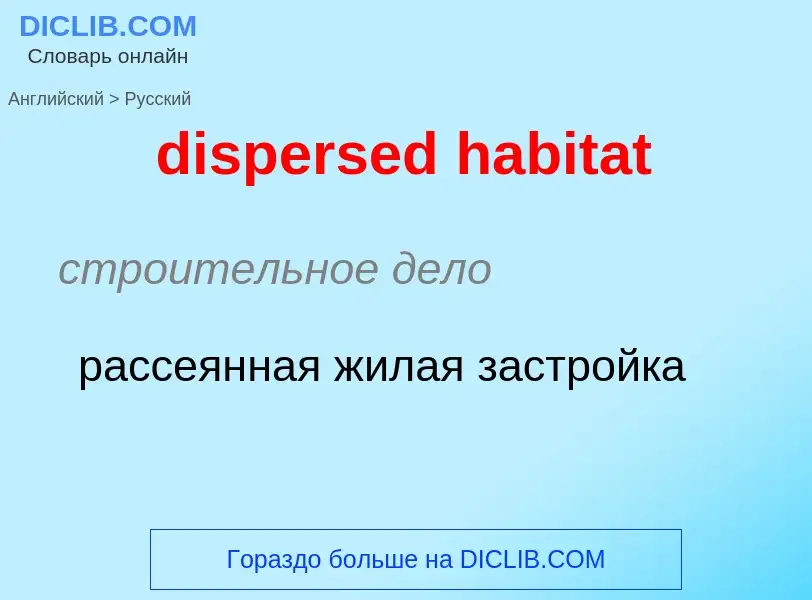Перевод и анализ слов искусственным интеллектом ChatGPT
На этой странице Вы можете получить подробный анализ слова или словосочетания, произведенный с помощью лучшей на сегодняшний день технологии искусственного интеллекта:
- как употребляется слово
- частота употребления
- используется оно чаще в устной или письменной речи
- варианты перевода слова
- примеры употребления (несколько фраз с переводом)
- этимология
dispersed habitat - перевод на русский
строительное дело
рассеянная жилая застройка
[eksə(u)'filik]
биология
экзофильный
экологически не зависящий от человека
прилагательное
биология
экзофильный
экологически не зависящий от человека
Определение
Википедия

Habitat destruction (also termed habitat loss and habitat reduction) is the process by which a natural habitat becomes incapable of supporting its native species. The organisms that previously inhabited the site are displaced or dead, thereby reducing biodiversity and species abundance. Habitat destruction is the leading cause of biodiversity loss. Fragmentation and loss of habitat have become one of the most important topics of research in ecology as they are major threats to the survival of endangered species.
Activities such as harvesting natural resources, industrial production and urbanization are human contributions to habitat destruction. Pressure from agriculture is the principal human cause. Some others include mining, logging, trawling, and urban sprawl. Habitat destruction is currently considered the primary cause of species extinction worldwide. Environmental factors can contribute to habitat destruction more indirectly. Geological processes, climate change, introduction of invasive species, ecosystem nutrient depletion, water and noise pollution are some examples. Loss of habitat can be preceded by an initial habitat fragmentation.
Attempts to address habitat destruction are in international policy commitments embodied by Sustainable Development Goal 15 "Life on Land" and Sustainable Development Goal 14 "Life Below Water". However, the United Nations Environment Programme report on "Making Peace with Nature" released in 2021 found that most of these efforts had failed to meet their internationally agreed upon goals.




![Farmers near newly cleared land within Taman Nasional Kerinci Seblat ([[Kerinci Seblat National Park]]), [[Sumatra]] Farmers near newly cleared land within Taman Nasional Kerinci Seblat ([[Kerinci Seblat National Park]]), [[Sumatra]]](https://commons.wikimedia.org/wiki/Special:FilePath/Farmland-batang bungo.jpg?width=200)
.jpg?width=200)
![The draining and development of coastal wetlands that previously protected the [[Gulf Coast]] contributed to severe flooding in New Orleans, Louisiana, in the aftermath of [[Hurricane Katrina]] in 2005.<ref>Tibbetts, 2006.</ref> The draining and development of coastal wetlands that previously protected the [[Gulf Coast]] contributed to severe flooding in New Orleans, Louisiana, in the aftermath of [[Hurricane Katrina]] in 2005.<ref>Tibbetts, 2006.</ref>](https://commons.wikimedia.org/wiki/Special:FilePath/KatrinaNewOrleansFlooded edit2.jpg?width=200)

![The leaves of an ''[[Alnus nepalensis]]'' tree provide a microhabitat for species like the leaf beetle ''[[Aulacophora indica]]''. The leaves of an ''[[Alnus nepalensis]]'' tree provide a microhabitat for species like the leaf beetle ''[[Aulacophora indica]]''.](https://commons.wikimedia.org/wiki/Special:FilePath/A leaf beetle (Aulacophora indica) peeking from a leaf hole of an Alnus nepalensis tree (cropped).jpg?width=200)
 18.jpg?width=200)
![An Antarctic rock split apart to show [[endolithic]] lifeforms showing as a green layer a few millimeters thick An Antarctic rock split apart to show [[endolithic]] lifeforms showing as a green layer a few millimeters thick](https://commons.wikimedia.org/wiki/Special:FilePath/Cryptoendolith.jpg?width=200)


![Rich rainforest habitat in [[Dominica]] Rich rainforest habitat in [[Dominica]]](https://commons.wikimedia.org/wiki/Special:FilePath/Epiphytes (Dominica).jpg?width=200)

![Twenty-five years after the devastating eruption at [[Mount St. Helens]], United States, [[pioneer species]] have moved in. Twenty-five years after the devastating eruption at [[Mount St. Helens]], United States, [[pioneer species]] have moved in.](https://commons.wikimedia.org/wiki/Special:FilePath/Mt st helens Johnston ridge 25 years later.jpg?width=200)
